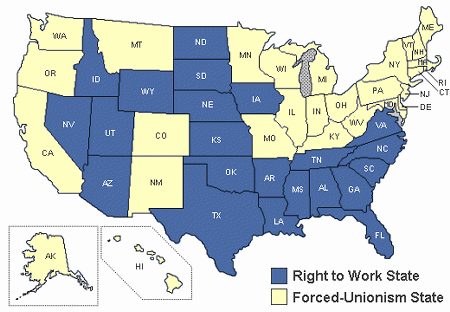This may just be a coincidence but, out of the 50 states, there are 22 states that do not force people to pay union dues as a condition of employment. Workers in these states are often viewed derisively by union extremists as being somehow inferior to their union counterparts. However, a new study published by CNBC may blow that myth out of the water.
When it comes to America’s Top States for Business 2011, when it comes to a quality workforce, 18 out of the top 20 states are Right-to-Work states. Moreover, all 22 Right-to-Work states are in the top 25 states for having the best workforces.
CNBC defines its criteria as this:
Many states point with great pride to the quality and availability of their workers, as well as government-sponsored programs to train them. We rated states based on the education level of their workforce, as well as the numbers of available workers. We also considered union membership. While organized labor contends that a union workforce is a quality workforce, that argument, more often than not, doesn’t resonate with business. We also looked at the relative success of each state’s worker training programs in placing their participants in jobs.
Since nine out of 10 of the states cited for having the best education are not right to work states, it appears that those who receive their educations in forced-union states get smart, pack up and leave, leaving the not-so-smart union extremists to invent myths about their own superiority while they pay their forced union dues.
Of course, it could all just be a coincidence but it does make one wonder who really has the low, sloping foreheads.
[Map via National Right to Work Legal Defense Foundation.]
_________________
“I bring reason to your ears, and, in language as plain as ABC, hold up truth to your eyes.” Thomas Paine, December 23, 1776








“To determine the effect of right-to-work laws on wages we estimate log wage equations using the Bureau of Labor Statistic’s current population survey-outgoing rotation group (CPS-ORG) data for 2000. The sample consists of 152,576 prime age workers, ages 18-64, who earn wages or salaries. Average hourly wages for the sample were $15.54, and median hourly wages were $12.25. Median wages for workers living in right-to-work states were $11.45, while wages for those living in non-RTW states were $13.00, indicating that wages were 11.9% lower in RTW states.”
I get it. It helps business make a profit by paying workers less.
The salary of a job is based on the value of the work to the company, not a social equality scale. More profits means more money to expand and hire additional workers. Any worker has the right to trot on over to a unionized environment if they please. That doesn’t seem to be happening given the extremes organizers are taking to unionize.
ha ha bluezguise i could not have said it better myself.. you see, the union workers are stuck in the 60’s with the hippie Humanist School of Psychology, which states that everyone no matter how well, or unwell they do a job is worth a great value and deserve a reward for trying their hardest. well sorry not everyone is meant to be a winner. A worker is only worth his skill. not his seniority or devotion to a business. that is what makes business valuable. Because you always have to watch your back and better yourself or someone else will better you.